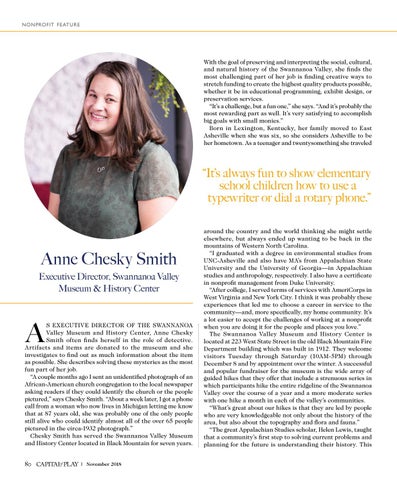nonprofit fe ature
With the goal of preserving and interpreting the social, cultural, and natural history of the Swannanoa Valley, she finds the most challenging part of her job is finding creative ways to stretch funding to create the highest quality products possible, whether it be in educational programming, exhibit design, or preservation services. “It’s a challenge, but a fun one,” she says. “And it’s probably the most rewarding part as well. It’s very satisfying to accomplish big goals with small monies.” Born in Lexington, Kentucky, her family moved to East Asheville when she was six, so she considers Asheville to be her hometown. As a teenager and twentysomething she traveled
“It’s always fun to show elementary school children how to use a typewriter or dial a rotary phone.”
Anne Chesky Smith
Executive Director, Swannanoa Valley Museum & History Center
A
S EXECUTIVE DIRECTOR OF THE SWANNANOA Valley Museum and History Center, Anne Chesky Smith often finds herself in the role of detective. Artifacts and items are donated to the museum and she investigates to find out as much information about the item as possible. She describes solving these mysteries as the most fun part of her job. “A couple months ago I sent an unidentified photograph of an African-American church congregation to the local newspaper asking readers if they could identify the church or the people pictured,” says Chesky Smith. “About a week later, I got a phone call from a woman who now lives in Michigan letting me know that at 87 years old, she was probably one of the only people still alive who could identify almost all of the over 65 people pictured in the circa-1932 photograph.” Chesky Smith has served the Swannanoa Valley Museum and History Center located in Black Mountain for seven years. 80
| November 2018
around the country and the world thinking she might settle elsewhere, but always ended up wanting to be back in the mountains of Western North Carolina. “I graduated with a degree in environmental studies from UNC-Asheville and also have MA’s from Appalachian State University and the University of Georgia—in Appalachian studies and anthropology, respectively. I also have a certificate in nonprofit management from Duke University. “After college, I served terms of services with AmeriCorps in West Virginia and New York City. I think it was probably these experiences that led me to choose a career in service to the community—and, more specifically, my home community. It’s a lot easier to accept the challenges of working at a nonprofit when you are doing it for the people and places you love.” The Swannanoa Valley Museum and History Center is located at 223 West State Street in the old Black Mountain Fire Department building which was built in 1912. They welcome visitors Tuesday through Saturday (10AM-5PM) through December 8 and by appointment over the winter. A successful and popular fundraiser for the museum is the wide array of guided hikes that they offer that include a strenuous series in which participants hike the entire ridgeline of the Swannanoa Valley over the course of a year and a more moderate series with one hike a month in each of the valley’s communities. “What’s great about our hikes is that they are led by people who are very knowledgeable not only about the history of the area, but also about the topography and flora and fauna.” “The great Appalachian Studies scholar, Helen Lewis, taught that a community’s first step to solving current problems and planning for the future is understanding their history. This
